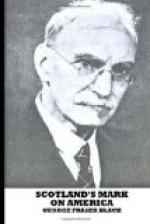John Crookshanks King (1806-82), born in Kilwinning, Ayrshire, emigrated to America in 1829, and died in Boston, was celebrated for his busts of Daniel Webster, John Quincy Adams, Louis Agassiz, the naturalist, Ralph Waldo Emerson, etc. He also excelled as a maker of cameo portraits. Thomas Crawford (1814-57), one of the greatest if not the greatest sculptor of America, was of Scottish descent. His works include “Armed Liberty” (bronze doors), Beethoven, bust of John Quincy, Washington, “Orpheus,” etc. Frederick William MacMonnies, born in Brooklyn in 1863 of Scottish parents (his father was a native of Whithorn, Wigtownshire), is sculptor of the statue of Nathan Hale in City Hall Park, New York; “Victory” at West Point, etc. Robert Ingersoll Aitken, born in San Francisco of Scottish parents, is designer of the monuments to President McKinley at St. Helena, Berkeley, and in Golden Gate Park, San Francisco. He also designed the monument to the American Navy in Union Square, San Francisco. In 1906 he moved to New York and has executed busts of some of the most prominent Americans of the day. Notable of his ideal sculptures are “Bacchante” (1908), “The Flame” (1909), and “Fragment” (1909). John Massey Rhind, Member of the National Sculpture Society, one of the foremost sculptors of the present day, was born in Edinburgh in 1858. James Wilson, Alexander Macdonald (1824-1908), and Hermon Atkins MacNeil (1866) are also of Scottish origin.
Alexander Milne Calder, born in Aberdeen, Scotland, in 1846, began life as a gardener, studied with Alexander Brodie and John Rhind and in London and Paris, came to America in 1868, and is best known as having made the sculpture for the Philadelphia City Hall including the heroic statue of William Penn, which crowns the tower. His son, Alexander Stirling Calder, born in Philadelphia in 1870, is also a sculptor of note, and was acting chief of the Department of Sculpture, Panama-Pacific Exposition, San Francisco, 1913-1915. Robert Tait MacKenzie, born in Ontario, Canada, in 1867, son of Rev. William Mackenzie, a graduate of Edinburgh, has created several groups of athletes in action of great force and beauty. Dr. Mackenzie is a physician and director of the Department of Physical Education in the University of Pennsylvania.
Thomas MacBean, the architect of St. Paul’s Chapel, Broadway, New York City, built in 1764-66, was a Scot who received his training under James Gibbs (an Aberdonian), architect of St. Martin-in-the-Fields, London. John Notman (1810-65), born in Edinburgh, designed and constructed some of the most important buildings in Philadelphia and also the State Capitol, Trenton. James Renwick (1818-95), born in New York city of Scottish ancestry, planned the distributing reservoir on Fifth Avenue, New York, where the New York Public Library now stands. He was one of the greatest architects in this country, and the beauty of his work—to cite only a few of his most




